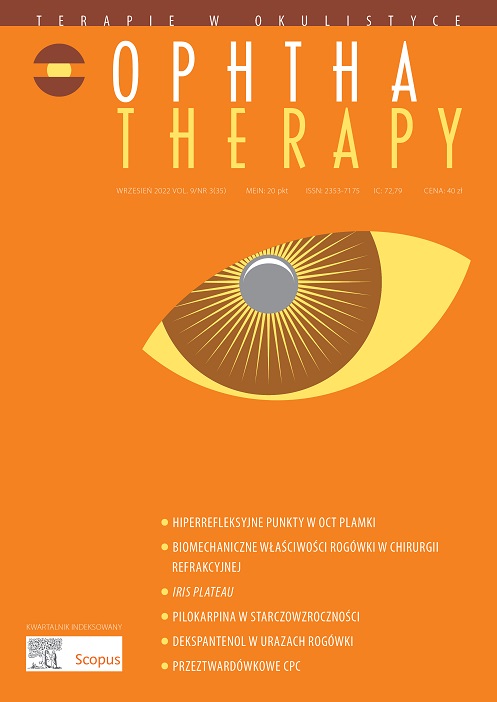The use of pilocarpine in the treatment of presbyopia Review article
Main Article Content
Abstract
Presbyopia is a physiological process of progressive loss of accommodation, which leads to a deterioration in the ability to focus vision on objects at different distances. This is now thought to be a direct consequence of two causes: the design of the transparent lens and the way it has to change shape to allow focusing, and the instability of proteins over very long periods of time. In recent years, various substances that temporarily narrow the pupil, causing a pinhole effect, have been intensively investigated to allow improved near vision acuity. The most commonly researched is 1.25% pilocarpine solution. The substance itself has been known for more than 100 years, with a well-documented hypotensive effect and numerous side effects. However, the reduced concentration and less frequent dosing, as well as the addition of drugs with anti-inflammatory effects currently being studied, offer hope for efficacy in the treatment of presbyopia. The results of the studies so far are promising. Researchers point to improved near visual acuity and a low rate of mild side effects. In the future, we will find out whether the optimistic observations mainly in short-term studies will also be effective and applicable in broad practice.
Downloads
Article Details
Copyright: © Medical Education sp. z o.o. License allowing third parties to copy and redistribute the material in any medium or format and to remix, transform, and build upon the material, provided the original work is properly cited and states its license.
Address reprint requests to: Medical Education, Marcin Kuźma (marcin.kuzma@mededu.pl)
References
2. Wolffsohn JS, Davies LN. Presbyopia: Effectiveness of correction strategies. Prog Retin Eye Res. 2019; 68: 124-43.
3. Benozzi J, Benozzi G, Orman B. Presbyopia: a new potential pharmacological treatment. Med Hypothesis Discov Innov Ophthalmol. 2012; 1(1): 3-5.
4. Grzybowski A, Ruamviboonsuk V. Pharmacological Treatment in Presbyopia. J Clin Med. 2022; 11(5): 1385.
5. Costa CM, Louvisse de Abreu LC, dos Santos EP et al. Preparation and evaluation of chitosan submicroparticles containing pilocarpine for glaucoma therapy. Curr Drug Deliv. 2015; 12(5): 491-503.
6. Price FW, Hom M, Moshirfar M et al. Combinations of Pilocarpine and Oxymetazoline for the Pharmacological Treatment of Presbyopia: Two Randomized Phase 2 Studies. Ophthalmology Science. 2021; 1(4): 100065.
7. Visus Therapeutics Announces Positive Topline Clinical Data from Phase 2 VIVID Study of BRIMOCHOL for the Treatment of Presbyopia.
8. Benozzi G, Perez C, Leiro J et al. Presbyopia treatment with eye drops: an eight year retrospective study. Transl Vis Sci Technol. 2020; 9(7): 25.
9. Waring GO 4th, Price FW, Jr., Wirta D et al. Safety and Efficacy of AGN-190584 in Individuals With Presbyopia: The GEMINI 1 Phase 3 Randomized Clinical Trial. JAMA Ophthalmol. 2022; 140(4): 363-71.

